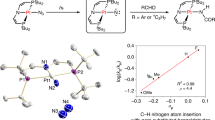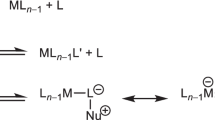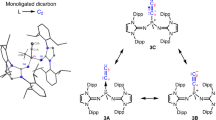Abstract
THE nuclear magnetic resonance and infra-red spectra1,2 of potassium tris acetylacetonatoplatinum(II) suggest that the acetylacetone anions form a square planar arrangement around the platinum with one conventional oxygen-bonded acetylacetone chelate and two γ-carbon bonded ligands. The complex reacts with hydrochloric and hydrobromic acids to give greenish-yellow complexes of composition C10H14O3PtX2 (X = Cl, Br) which are monomeric in chloroform and non-electrolytes in nitromethane. In contrast to the ‘acid’ derivatives3 of the complex K[Pt(Acac)2X], these complexes are stable in solution for several days.
This is a preview of subscription content, access via your institution
Access options
Subscribe to this journal
Receive 51 print issues and online access
$199.00 per year
only $3.90 per issue
Buy this article
- Purchase on Springer Link
- Instant access to full article PDF
Prices may be subject to local taxes which are calculated during checkout
Similar content being viewed by others
References
Figgis, B. N., Lewis, J., Long, R. F., Mason, R., Nyholm, R. S., Pauling, P. J., and Robertson, G. B., Nature, 195, 1278 (1962).
Oldham, C., and Lewis, J. (in the press).
Allen, G., Long, R., Lewis, J., and Oldham, C., Nature, 202, 589 (1964).
Author information
Authors and Affiliations
Rights and permissions
About this article
Cite this article
GIBSON, D., OLDHAM, C., LEWIS, J. et al. Structure of a Diolefine Complex of Platinum(II) C10H14O3PtCl2. Nature 208, 580–581 (1965). https://doi.org/10.1038/208580a0
Issue Date:
DOI: https://doi.org/10.1038/208580a0
This article is cited by
Comments
By submitting a comment you agree to abide by our Terms and Community Guidelines. If you find something abusive or that does not comply with our terms or guidelines please flag it as inappropriate.



